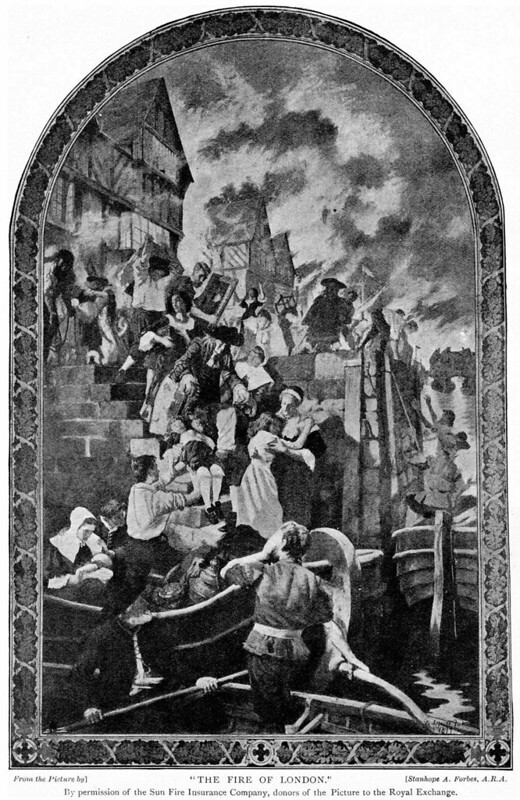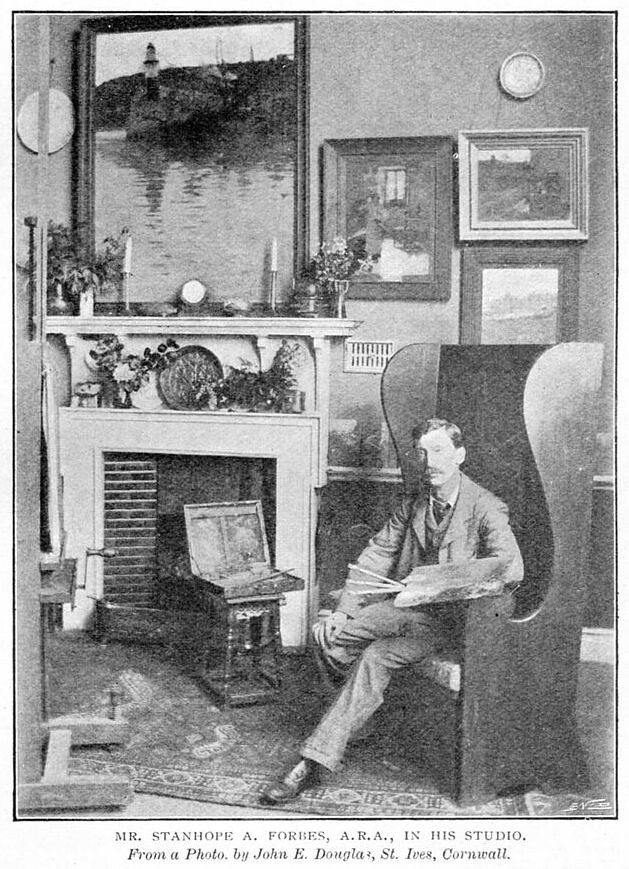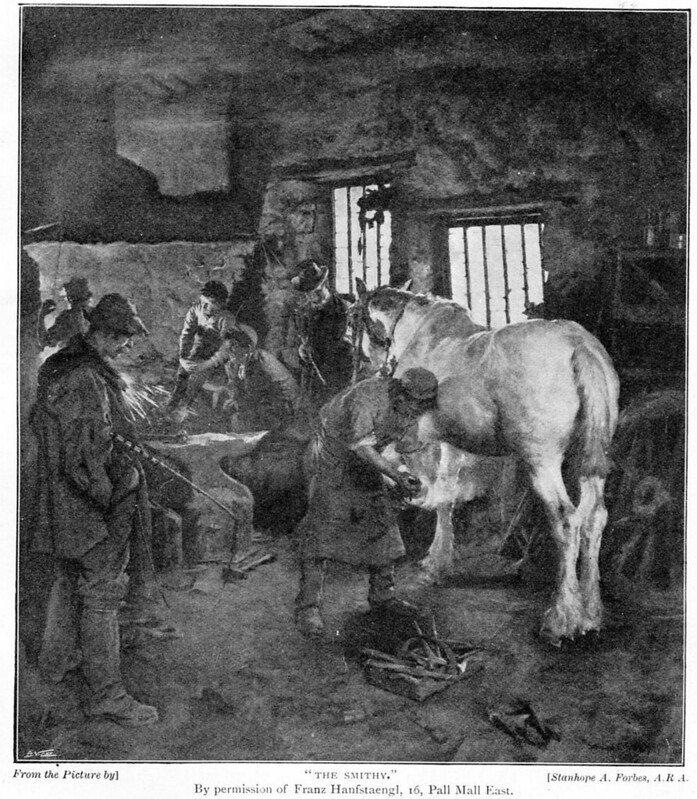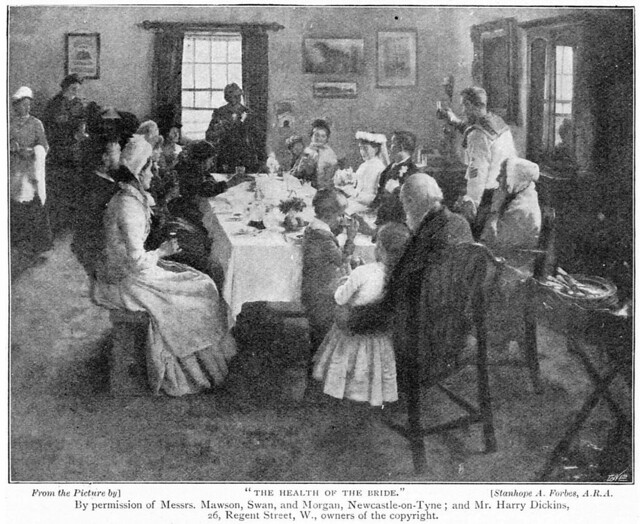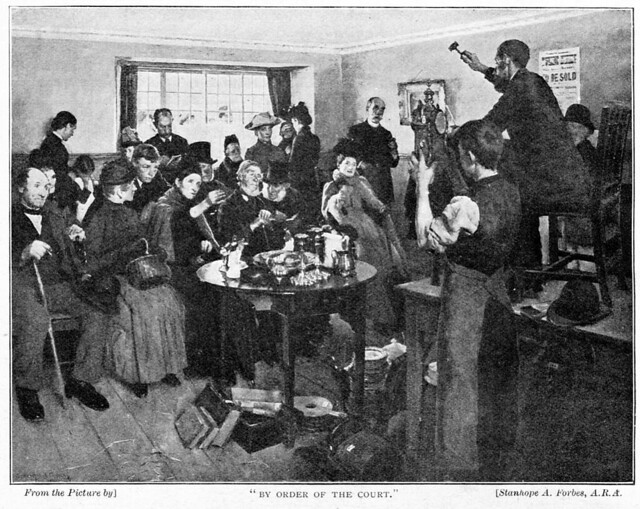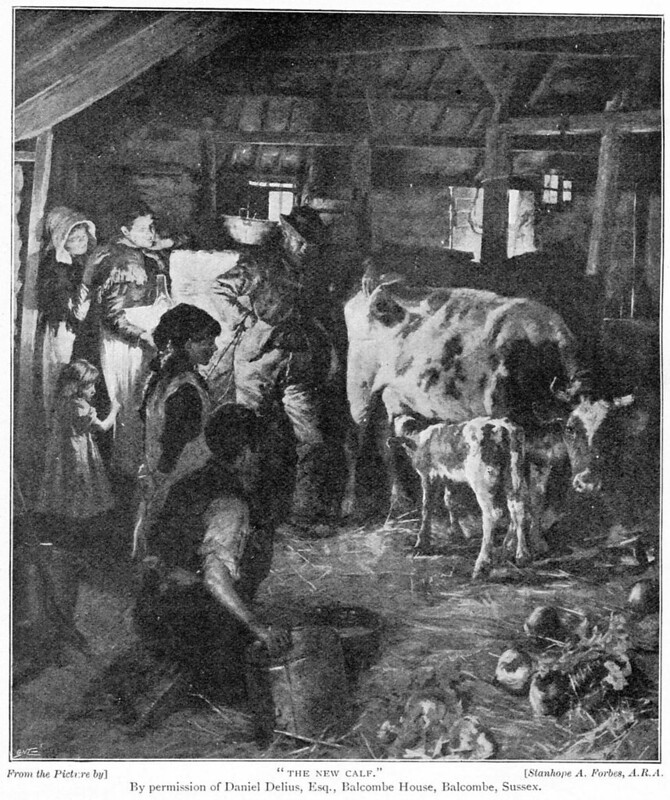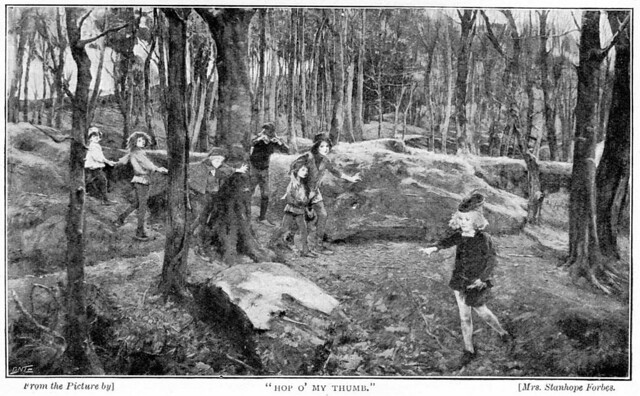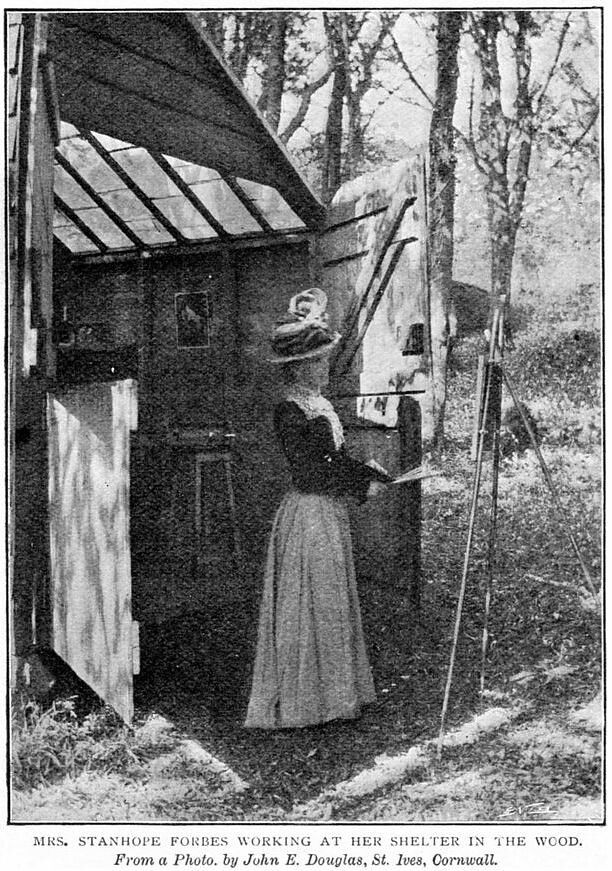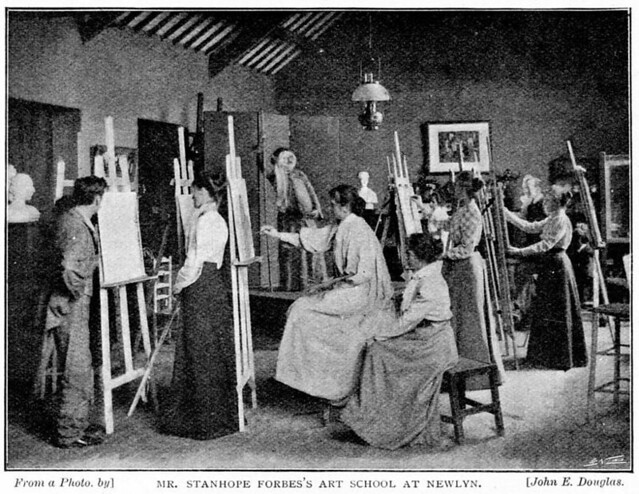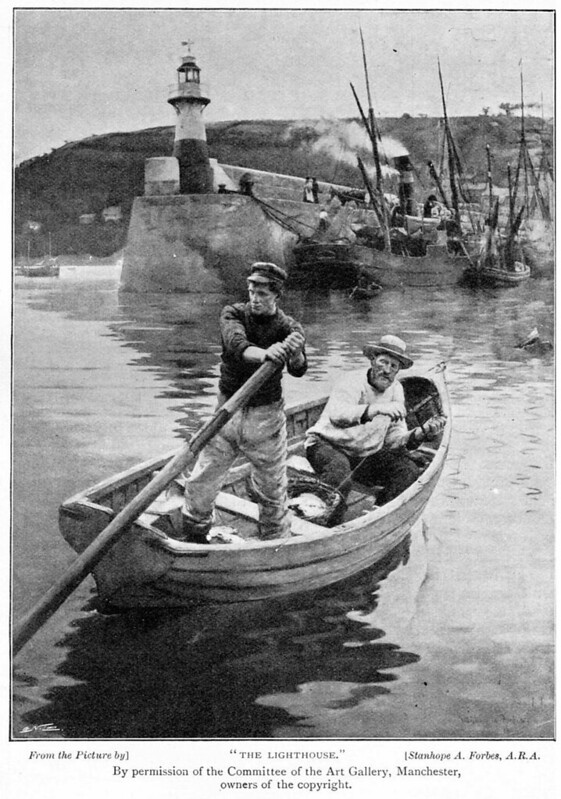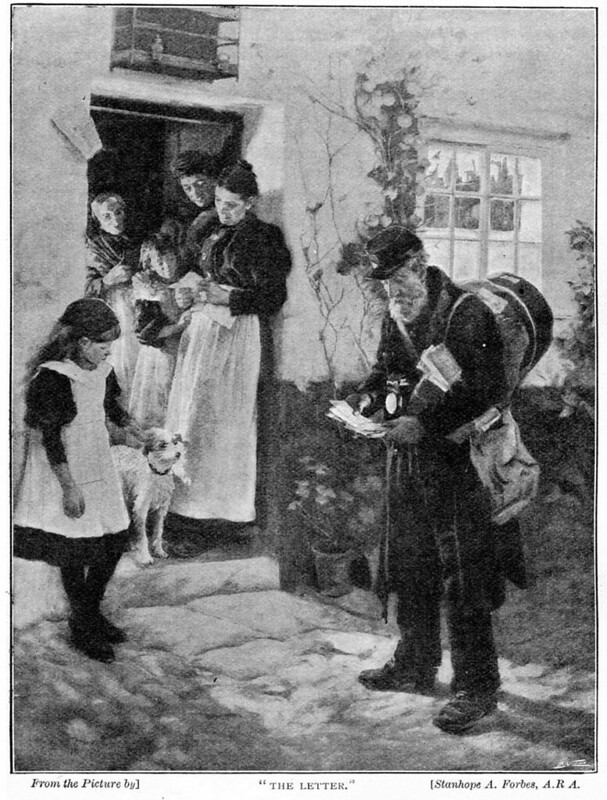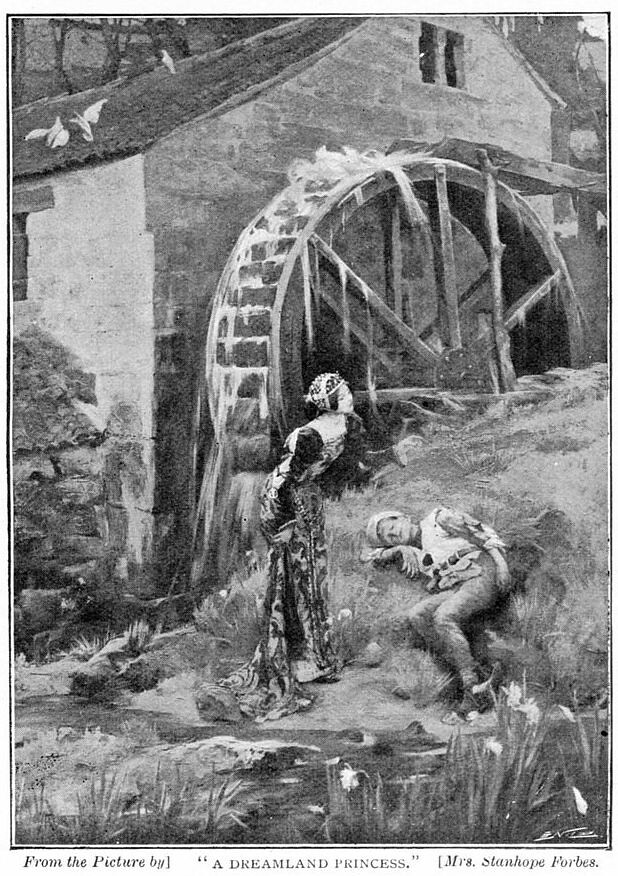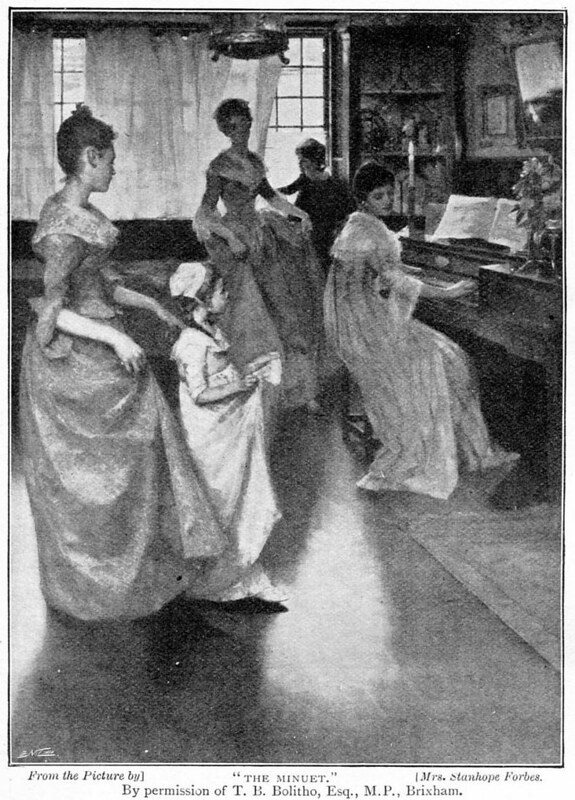One of a long running series of Illustrated Interviews. Stanhope Forbes lived until 1947, and his Newlyn School of painting continued to be influential long after the publication of this article. Several of the paintings below are by his wife, Elisabeth Forbes, and as usual for mainstream Victorian tastes, they seem to have picked the twee-est possible out of her body of work. The wikipedia article on Stanhope Forbes has a reproduction of one of his paintings from the end of the first World War, and it’s interesting to see how his style developed.
Everybody in Newlyn seems to know Mr. Stanhope Forbes. Thrice have I to seek the direction to “Trewarveneth” (although had I known that the name of the painter’s house was Cornish for “Top of the Hill” it would doubtless have been found easily enough), but in each instance, from fisherman mending his nets, from housewife washing the clothes, and a carter leading his team, the response was very ready and explicit. The painter of so many Newlyn interiors, the leader of the little band of artists who have given the Cornish fishing village a worldwide fame, is evidently very much “at home” with the simple little community in which he has lived for the last sixteen years.
In my walk from Penzance along the sea-front I pass the picture-gallery presented by Mr. Passmore Edwards to the Newlyn artists, cross the bridge over a little stream of which Mr. Forbes has made so pleasing a picture, and, turning away from quay and harbour, begin the ascent of what is locally known as Paul Hill. This road takes one to the back of the village, giving extensive views of Newlyn as a whole, but not introducing you to the picturesque harbour, which I afterwards find to be its greatest charm, as the Royal Academy exhibition had led me to expect. Mr. Forbes’s house is right on the crest of the hill, the village beginning some distance below it and sloping down to the water’s edge. Once the residence of a well-known Cornish family, “Trewarveneth” was for many years a farm-house, and in adapting it to his needs Mr. Forbes has not altered it much. A five-barred gate and a short road through field and hedge-row lead you to expect some such old, cottage-like dwelling, which still bears, although in rather illegible figures, a date of the seventeenth century. Apart from the large studio, built like the house in the grey stone which is characteristic of the county, Mr. Stanhope Forbes has added nothing more than a glass conservatory and a latticed porch to the door. With its small casements and low, timbered roof “Trewarveneth,” as a bit of old Newlyn, is doubtless dear to the painter’s heart.
“I came to Newlyn for a fortnight and I have stayed sixteen years,” says Mr. Forbes, receiving me in the little drawing-room which, daintily furnished as it is, has still the beamed ceiling and the projecting chimney-corner of old. “I had just returned from Brittany, and was looking around for a fresh sketching-ground. A friend suggested the Cornish coast. We settled at Manaccan, on the other side of Mount’s Bay, but finding the place lacked interest for a figure painter I took my knapsack, went exploring on my own account, and ultimately found myself at Newlyn. The place from the first greatly attracted me; in a day or two it suggested ‘The Fish Sale,’ and so I stopped on here, working mainly at this picture, which, exhibited at the Royal Academy in 1885, was one of the first of any size and importance to emanate from Newlyn. The same year saw Mr. Walter Langley’s “Among the Missing,” one of the finest works of this well-known water-colour painter.
“The success of ‘The Fish Sale’ only confirmed my first impression that there was at Newlyn and its immediate neighbourhood any amount of fresh material for the artist. I am of the same opinion to-day, after all the work of all the men of what has been called the Newlyn School. There are still any number of subjects which have not yet been touched. Perhaps I should not have settled at Newlyn, however, if I had not met my wife here. We were married at the village church in 1889. For some time we lived right in the heart of the village, among the fisher-folk; we did not take this house till about seven years ago.”
“What is now the size of the artists’ colony at Newlyn?”
“It is not so large as it was formerly, and several of our best, Frank Bramley, T. C. Gotch, Fred Hall, and others have left us; but we still muster a goodly number on those occasions when at each other’s houses we gather together of an evening. For we have no club at Newlyn, except a dramatic club, which every now and then comes to life and gives a performance in aid of some local charity. We have also an orchestral society, a circumstance which suggested my picture, ‘The Village Philharmonic’ Before that time I had never touched an instrument myself. But I had to buy a violoncello in order to paint it in this picture, and somehow or other I got interested in the instrument. I had to work hard for a long time before I could do anything with it, but I now find the ‘cello-playing such a pleasant recreation that I don’t regret my waste of time.”
The studio, into which Mr. Forbes now leads me by way of a conservatory gay with lilies and geraniums, is both large and lofty; but it was not large or lofty enough for the dimensions of his fresco, “The Fire of London,” for the Royal Exchange–the most important picture he has painted without a Newlyn background. The canvas had to be painted in sections.
“But was it not difficult, Mr. Forbes, to work at such a picture here–so far away from the Thames?”
“No, not after I had spent some days in the library of the British Museum, making sketches of old prints, etc., and had taken a mental photograph of the sort of Thames scene which I intended painting. Of course, I had to bring the costumes down from London, but there was no trouble about getting the models I wanted from among the people of Newlyn. There never was such a place for good characteristic models, both men and women, and they pose naturally and patiently.”
Looking round the studio, which has all the tidiness of the recess after sending-in day at the Academy, I notice the work of several well-known Newlyn artists besides my host. Among other original studies of Mr. Forbes’s own pictures are those of “The Smithy,” “The New Calf,” and “The Quarry Team.” The study for “The Smithy,” I observe, shows sundry tears and scratches in the canvas. And thereby hangs a tale.
“Years after I had painted and sold–and therefore pretty well forgotten–‘The Smithy,’ a friend came to me one day and declared that he had seen a picture of mine in a labourer’s cottage serving the purpose of a fire-screen. It was in a village near here, called Sheffield. I went over to Sheffield and found this original study for ‘The Smithy’ fulfilling the useful function my friend had described. The woman seemed quite sorry to part with it–she said it was such an excellent screen. The cottage was close by the village blacksmith’s where I had painted the study, and I remember that I had been accustomed to leave the canvas at this cottage overnight instead of carrying it to and fro.”
“Was ‘The Smithy’ actually painted in a blacksmith’s shop, then?”
“Yes, down to the smallest detail. I found it rather tiring work, I remember, owing to the heat and the noise. Every now and then I had to fly helter-skelter with brushes, palette, and canvas to escape from the cloud of smoke. In the same way I painted ‘Forging the Anchor,’ which is sometimes confounded with my ‘Smithy,’ in a small Newlyn foundry. In both cases the workmen were pleased and flattered by my suggestion of painting them at their work, but I am afraid I tried their patience sorely before I had finished. In such circumstances I never dare to tell people how long I shall take to paint my picture, when it may be weeks or months.”
“The Health of the Bride,” the picture which represents Mr. Forbes in the New National Gallery at Millbank, was painted mainly in the artist’s own studio under circumstances of greater comfort. “I remember,” Mr. Forbes continued, “that one debatable point was settled by a most opportune piece of real experience. I was anxious that my bride should have wreath and veil for the sake of picturesque effect, but several friends strongly represented to me that at a village wedding of the kind I was painting the bride never did have a wreath and veil, and that I was, therefore, spoiling the realism of the picture. The lady who afterwards became my wife came one day across a village wedding, just such a wedding as I was painting. She looked anxiously at the bride–yes, she had both wreath and veil. She waited till the ceremony was over and then ran after the party and obtained the loan of both articles for me to paint. No, I didn’t borrow the bride as well, for all my models were already sitting for me, village people whom I had carefully chosen for their various parts.
“The scene of this picture, by the way, is supposed to be the best parlour of a village inn. It is the Cornish custom for a wedding party after the ceremony is over to partake of a meal at an inn and then take a drive of a few miles, ‘going foreign,’ as Newlyn people, who rarely leave their native village, call it. Standing in one of these inn parlours I had first thought of painting an anglers’ meeting–you will notice one or two cases of fish on the wall–but it afterwards occurred to me that a wedding party could be much more picturesquely grouped, even though one had to paint them in the smarter, more conventional Sunday clothes.”
“How did you come to paint your picture, ‘By Order of the Court,’ Mr. Forbes?”
“Through attending so many of the auction sales at farms and country houses hereabouts in the hope of picking up odd things for my home and studio. All the details of the scene were stamped upon my memory, and I had no difficulty in painting them. For some of the figures I got models from among the village people in the usual way, but for several I had to induce friends to sit, a common practice among painters of the Middle Ages.”
Mrs. Stanhope Forbes comes to summon us to her tea-table on the lawn. At Newlyn there is apparently nothing extraordinary about tea in the garden on an April afternoon, and in sunshine which is genial without being hot, amidst daffodils and narcissus, a most pleasant incident it proves to be.
At tea the conversation turns to the exhibition of Mrs. Stanhope Forbes’s work, which was then taking place in Bond Street, work which had occupied her during the greater part of the previous year. In several of these small pictures her son Alec, aged five, was the principal figure. I learned with regret that the original of these charming studies of child life was just then away from home.
Mrs. Stanhope Forbes is very fond of painting the rural scenery near Newlyn, such as she has given us in “Moorland Princesses” and “Hop o’ my Thumb.” For such pictures she uses a movable painting hut, wherein she can comfortably work in all kinds of weather. Just now the hut stands in a beautiful wood, five or six miles away, where she had done a good deal of work for her Bond Street exhibition. Mr. and Mrs. Forbes, like nearly all the Newlyn artists, are both enthusiastic cyclists, and find their machines most convenient in reaching distant painting grounds.
In “the cool of the evening” Mr. Forbes takes me for a ramble through Newlyn as he has painted it. We reach the high road, passing through a kitchen-garden and along a lane cut through pasture-fields and inclosed by high hedges, familiarly known as “The Terrace.” We pause at the wicket-gate at the end of this lane to enjoy the view before descending the hill–a view of the harbour filled with fishing-boats, of Penzance and St. Michael’s Mount in the distance. From the high road we turn into the quaint Newlyn streets, hardly wide enough to admit any vehicular traffic, and paved with stones of so many different shapes and sizes that in descending to the harbour the pedestrian stranger has need of some caution lest he should go down headlong.
Mr. Forbes shows me the fisherman’s cottage, with thatched roof and weather-stained walls, in which Mr. Frank Bramley, A.R.A., painted his well-known picture, “A Hopeless Dawn.” It was his studio for a time, and by the side of the cottage a piece of wood is still fixed on which have been painted the words, “Rue des Beaux Arts,” reminiscent of the humour of some students recently returned from Paris, which at the time much puzzled the natives. Close by is the meadow–once grass land in the centre of the village overlooking the bay–now a cultivated garden. In this have been built a number of studios and glass-houses, where at one time or other nearly all the painters whose names are associated with Newlyn have worked. Several of these are now filled with Mr. and Mrs. Forbes’s pupils, for they have now a flourishing art school here, and a considerable number of students work, under their direct supervision. Here is the large studio in which they draw and paint from the life, finding characteristic models amongst the village folk, and near at hand, under the trees, is a shady plateau, where, in fine weather, the class meets for the study of open-air painting. The students have come from all parts of the country, and Mr. and Mrs. Forbes look forward with confidence to the effect their school will have in insuring the permanency of Newlyn as an artists’ settlement.
Just above here Mr. Forbes has his own glass-house, wherein he works chiefly for atmospheric effects in the wet grey days, which are perhaps the most distinctive feature of Cornish winters. With studio and glass-house he is able to paint in all the weathers that Newlyn knows much of.
At the door of one of the smallest cottages the artist stopped with the exclamation: “Let me introduce you to Grace, an old acquaintance who has figured in more than one of my pictures.”
Having gently rapped at the door and received a feeble response Mr. Forbes lifts the latch. It is quite a tiny room, crowded with old furniture and adorned with quaint ornaments of still older fashion. In the chimney-corner, crouched over the fire, was an old woman in whom I think I recognised the features of the grandmother in “The Health of the Bride.” Grace receives the painter and his friend very cordially, and seems pleased when I speak of her pictorial appearances. Doubtless the fees she still receives as a “model” contribute not a little to the comfort of her very old age. But a question as to the number of her years is quietly ignored. Upon that point, Mr. Forbes tells me, Grace will say nothing. No one in Newlyn knows how old she really is.
Walking to the harbour, we passed the picturesque bit of Newlyn known as “The Slipway,” in which I recognise the subject of another canvas by Mr. Forbes. It is close to the new pier, on which nowadays the “catches” of the boats are sold by auction.
“These piers don’t add to the beauty of Newlyn,” Mr. Forbes remarks, “although the new harbour is doubtless a great boon. The scene of the fish sale on the sands yonder as I painted it was much prettier, although I remember that in making my sketches there in the early morning it was very wet and cold. From this slipway I remember once catching some fine mullet with a fishing-rod.”
“You must be an expert angler, Mr. Forbes.”
“I don’t know about that,” he replied, smiling, as he proceeded to explain how the feat was accomplished. “At one time I was rather fond of deep-sea fishing, and went out with the boats a good many nights.”
On the quayside a number of men, fishermen, fish-salesmen, and carters, are lounging about, chatting and smoking, some of whom look as if they had stepped out of Mr. Forbes’s pictures. Many of them greet the artist, and he indicates several to me as having been painted by him on various occasions. Here was the brawny carter, for instance, with immense whip, who appears as one of the bystanders in “Forging the Anchor,” there one of the “sailors and soldiers, too,” of “The Salvation Army”–in which picture all the models were actually “Salvationists.”
Mr. Forbes gives friendly recognition to a farmer and his wife riding behind a smart trotting cob. “It was on their farm,” he mentions, “that I painted my picture for last year’s Academy, the three horses drinking at a stream, to which I gave the title, ‘The Drinking Place.’ It is several miles from Newlyn, and when my day’s work was finished I used to be provided with tea at the farm-house.”
We next encountered the son of the vicar of Newlyn near his father’s church, where Mr. and Mrs. Forbes were married. This friend of the artist’s is known at Newlyn as “the vicar’s son,” but as “Perkins, the cricketer,” he enjoys fame throughout the country. The talk naturally turns upon cricket, and Mr. Forbes playfully challenges the distinguished amateur and his friends to a match with the artists’ cricket club in London. Mr. Forbes has been fond of the game in his time, and has taken part in more than one match between the painters of Newlyn and those of St. Ives.
“What was your first Academy picture, Mr. Forbes?”
“It was a portrait, the portrait of the daughter of a Harley Street doctor who was an old friend of my father. It was hung with the title of ‘Florence,’ and was sufficiently successful to bring me several commissions. My first sketching expedition was to Galway, and although a mere lad at the time I had been favoured with a commission through a family friend, to paint the portrait of a lady well known socially in the West of Ireland. In fact, I should have probably settled down as a portrait-painter but for the circumstance that in 1882 the Liverpool Corporation purchased a picture I had painted in Brittany, a street scene at Quimperle. This encouraged me to go on with my open-air painting, and proved to be quite a turning-point in my career.
“This incident was the more important to me–a young man who had his own way to make to a large extent–because of the great disappointment I had then recently experienced at the Academy. Having had two or three portraits accepted I sent in my third year three more portraits, and I had the mortification of receiving them all back. So the Liverpool Art Committee did me a very good turn indeed. I went on painting Brittany subjects, and with a fair amount of success, until I thought people were getting tired of them, my peasants necessarily looking so much alike with blue blouses and white caps. I read one day in the Pall Mall Gazette that ‘Mr. Forbes sees Nature as if he looked at it through blue spectacles,’ and this incisive though kindly notice led me to resolve upon a change of scene.”
Before the walk is ended I get an insight into one aspect of the influence which the artists are exercising upon the daily life of Newlyn. An old, somewhat dilapidated cottage, seemingly uninhabited, has a black-lettered title across its front wall–“Newlyn Industrial Class.”
“Here many of the young men of the place,” Mr. Forbes explains, “gather of an evening–fisher-lads, mostly–to work at copper and brass work. Mr. J. D. Mackenzie gives them instruction and provides them with his original designs, and they have really turned out some excellent work. I have a sconce and one or two other specimens in my own house, and most of the articles that are made now find, I believe, a ready sale through agents in various parts. The young fellows enjoy the hammering, and there is something appropriate, I think, about a copper and brass industry in Cornwall.”
With his somewhat slight figure and comparatively pale features Mr. Stanhope Forbes presents a dramatic contrast to the stoutly-built and ruddy-complexioned men and women among whom we have been moving.
The artist is a townsman by birth and breeding, and sixteen years’ residence at Newlyn has apparently not in the slightest degree affected the physical significance of this fact. Mr. Forbes is an Irishman by birth, although not by descent, having first seen the light in Dublin, in 1857, when his father, Mr. William Forbes, was manager of the Midland Great Western Railway of Ireland.
“My family,” he tells me, “afterwards lived at Dulwich, and I went to Dulwich College. La Thangue and one or two other artists were there at the same time. We had, as art master, Mr. J. C. L. Sparkes, of the Lambeth School of Art, and we also had the advantage, of course, of a fine collection of pictures on the premises. From the first I was very fond of drawing, and Sparkes took a lot of interest in me. It was through him that on leaving the college my father was induced to allow me to attend the Lambeth Art School with a view to my making a profession of art. After that I went to Brussels, where my father had become manager of the Luxembourg Railway, and I attended classes there as well as in Paris, my Paris master being M. Bonnat.”
“And you finished up, Mr. Forbes, at the Royal Academy School?”
“Yes, I was fortunately successful in obtaining admission at my first application, and the first picture I sent for exhibition was also accepted and well hung. I think it has been fairly plain sailing with me, although I can truly say that there has been plenty of hard work in my life. It is a great mistake to suppose that with a love for art success can be gained without hard work. I am sure that I love painting, but for my own part I find that the business of painting can be very arduous and fatiguing. It is so difficult to satisfy yourself that you have done your best.
“My father was in Brussels,” Mr. Forbes relates at the luncheon table next day, “during the Franco-German War, when for a long time there was an excited belief that the neutrality of Belgium would be violated. I happened to be there one day when a report came that the Germans were about to seize the Luxembourg Railway, and the railway officials came hurrying in with all the loose gold, notes, etc., to give them to my father for safe keeping. My father slept that night with I don’t know how many thousands of pounds under his pillow.”
In speaking of her own Continental experiences Mrs. Forbes mentions that she spent some months studying at Munich. But her art education was obtained chiefly as a member of the Art Students’ League of New York. Quite early in its career she was attracted by this remarkable organization of American art reformers from her home in Ottawa, where her father, Mr. William Armstrong, was a Civil Service official. Unlike some Canadians, Mrs. Forbes has not a trace of the Yankee accent, but these years in New York, at the most impressionable age, probably had some influence on her manner as well as her art.
During the day Mr. Forbes takes me down to the Passmore Edwards Art Gallery for the “private view ” of a new exhibition. Every month the walls of the gallery are replenished, the Newlyn artists, of course, being the principal contributors. It is the custom, too, for the Newlyn men to exhibit here their pictures for the Royal Academy, the New Gallery, etc., before they are sent to London for the judgment of “hanging committees,” and I notice on the walls of fishermen’s cottages one or two placards announcing this year’s show.
“I am not sure,” says Mr. Forbes, “that the people did not appreciate more our old ‘show days’ in the Meadow. Percy Craft and I first started, I think, the ‘private view’ in our studios, and in a year or two it became general. The Meadow would be crowded with people from far and near, who would make quite a picnic of it, looking through the studios, chatting on the grass, drinking tea and eating cake provided for them in the open air. It was, I can assure you, in many ways a most quaint and interesting scene, but, of course, when Mr. Passmore Edwards kindly built us a gallery this picture picnic had to be abandoned in favour of the more conventional exhibition.”
On entering the Gallery Mr. Forbes is soon introducing me to some of the members of the Newlyn colony. In talking of the work on the walls it is pleasing to observe with what cordiality and affection Mr. Stanhope Forbes, as the leader of the Newlyn School, is regarded by his comrades. Conversation by no means wholly, or even mainly, turns upon artistic “shop”; a fertile topic with several artists of varying age and fame being the condition and progress of flowers and vegetables in their gardens! In the easy neglige of country attire, with sunburnt features and jovial voices, they testify as a group to the healthfulness of the art life at Newlyn, to which it is Mr. Forbes’s hope and endeavour to give an enduring future.
